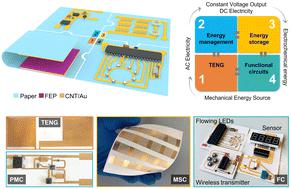当前位置:
X-MOL 学术
›
Energy Environ. Sci.
›
论文详情
Our official English website, www.x-mol.net, welcomes your
feedback! (Note: you will need to create a separate account there.)
Energy autonomous paper modules and functional circuits
Energy & Environmental Science ( IF 32.4 ) Pub Date : 2022-10-20 , DOI: 10.1039/d2ee02557d Jing Han 1, 2 , Nuo Xu 1, 3 , Jinran Yu 1, 2 , Yifei Wang 1, 2 , Yao Xiong 1, 2 , Yichen Wei 1, 3 , Zhong Lin Wang 1, 2, 4 , Qijun Sun 1, 2, 3
Energy & Environmental Science ( IF 32.4 ) Pub Date : 2022-10-20 , DOI: 10.1039/d2ee02557d Jing Han 1, 2 , Nuo Xu 1, 3 , Jinran Yu 1, 2 , Yifei Wang 1, 2 , Yao Xiong 1, 2 , Yichen Wei 1, 3 , Zhong Lin Wang 1, 2, 4 , Qijun Sun 1, 2, 3
Affiliation

|
Energy-efficient intelligent systems incorporating modern electronics, circuits, and power sources have rapidly become inseparable for a wide range of applications. Here, we propose a prototype of energy autonomous functional paper modules, which comprise triboelectric energy harvester, power management circuits (PMCs), energy storage units, and back-end functional circuits. Each of the paper modules has its specific function and can be used individually, incorporated, or replaced/selected depending on different circumstances. The fabricated paper modules are ready to convert mechanical energy into electricity through the paper-based triboelectric nanogenerator (paper-TENG) unit; the converted AC output can be delivered to the PMC paper module and regulated into DC output to improve the charging efficiency for energy storage units; the stored electrochemical energy can be successfully used to drive the back-end module of functional circuits (including flowing LEDs, temperature/humidity sensors, and wireless transmitters). The working process of the sustainable paper modules implies an energy circulation of mechanical energy conversion, electrochemical energy storage, and energy utilization in functional circuits (in the form of photonic, thermal, electromagnetic, or mechanical energy). The proposed energy-autonomous functional paper modules present new paradigm for sustainable and adaptive functional circuits to extend the broader path toward efficient, economical, and customized integrative electronics and complementary self-powered systems.
中文翻译:

能源自主纸模块和功能电路
结合现代电子设备、电路和电源的节能智能系统已迅速成为广泛应用不可分割的一部分。在这里,我们提出了能量自主功能纸模块的原型,包括摩擦电能量收集器、电源管理电路(PMC)、能量存储单元和后端功能电路。每个纸模块都有其特定的功能,可以根据不同的情况单独使用、合并或替换/选择。制造的纸模块可以通过纸基摩擦纳米发电机(paper-TENG)单元将机械能转化为电能;转换后的交流输出可以输送到PMC纸模块,调节成直流输出,提高储能单元的充电效率;存储的电化学能量可成功用于驱动功能电路的后端模块(包括流动的 LED、温湿度传感器和无线发射器)。可持续纸模块的工作过程意味着机械能转换、电化学能量储存和功能电路中的能量利用(以光子、热、电磁或机械能的形式)的能量循环。所提出的能量自主功能纸模块为可持续和自适应功能电路提供了新的范式,以扩展通往高效、经济和定制的集成电子设备和互补自供电系统的更广阔道路。温度/湿度传感器和无线发射器)。可持续纸模块的工作过程意味着机械能转换、电化学能量储存和功能电路中的能量利用(以光子、热、电磁或机械能的形式)的能量循环。所提出的能量自主功能纸模块为可持续和自适应功能电路提供了新的范式,以扩展通往高效、经济和定制的集成电子设备和互补自供电系统的更广阔道路。温度/湿度传感器和无线发射器)。可持续纸模块的工作过程意味着机械能转换、电化学能量储存和功能电路中的能量利用(以光子、热、电磁或机械能的形式)的能量循环。所提出的能量自主功能纸模块为可持续和自适应功能电路提供了新的范式,以扩展通往高效、经济和定制的集成电子设备和互补自供电系统的更广阔道路。电磁能或机械能)。所提出的能量自主功能纸模块为可持续和自适应功能电路提供了新的范式,以扩展通往高效、经济和定制的集成电子设备和互补自供电系统的更广阔道路。电磁能或机械能)。所提出的能量自主功能纸模块为可持续和自适应功能电路提供了新的范式,以扩展通往高效、经济和定制的集成电子设备和互补自供电系统的更广阔道路。
更新日期:2022-10-20
中文翻译:

能源自主纸模块和功能电路
结合现代电子设备、电路和电源的节能智能系统已迅速成为广泛应用不可分割的一部分。在这里,我们提出了能量自主功能纸模块的原型,包括摩擦电能量收集器、电源管理电路(PMC)、能量存储单元和后端功能电路。每个纸模块都有其特定的功能,可以根据不同的情况单独使用、合并或替换/选择。制造的纸模块可以通过纸基摩擦纳米发电机(paper-TENG)单元将机械能转化为电能;转换后的交流输出可以输送到PMC纸模块,调节成直流输出,提高储能单元的充电效率;存储的电化学能量可成功用于驱动功能电路的后端模块(包括流动的 LED、温湿度传感器和无线发射器)。可持续纸模块的工作过程意味着机械能转换、电化学能量储存和功能电路中的能量利用(以光子、热、电磁或机械能的形式)的能量循环。所提出的能量自主功能纸模块为可持续和自适应功能电路提供了新的范式,以扩展通往高效、经济和定制的集成电子设备和互补自供电系统的更广阔道路。温度/湿度传感器和无线发射器)。可持续纸模块的工作过程意味着机械能转换、电化学能量储存和功能电路中的能量利用(以光子、热、电磁或机械能的形式)的能量循环。所提出的能量自主功能纸模块为可持续和自适应功能电路提供了新的范式,以扩展通往高效、经济和定制的集成电子设备和互补自供电系统的更广阔道路。温度/湿度传感器和无线发射器)。可持续纸模块的工作过程意味着机械能转换、电化学能量储存和功能电路中的能量利用(以光子、热、电磁或机械能的形式)的能量循环。所提出的能量自主功能纸模块为可持续和自适应功能电路提供了新的范式,以扩展通往高效、经济和定制的集成电子设备和互补自供电系统的更广阔道路。电磁能或机械能)。所提出的能量自主功能纸模块为可持续和自适应功能电路提供了新的范式,以扩展通往高效、经济和定制的集成电子设备和互补自供电系统的更广阔道路。电磁能或机械能)。所提出的能量自主功能纸模块为可持续和自适应功能电路提供了新的范式,以扩展通往高效、经济和定制的集成电子设备和互补自供电系统的更广阔道路。











































 京公网安备 11010802027423号
京公网安备 11010802027423号